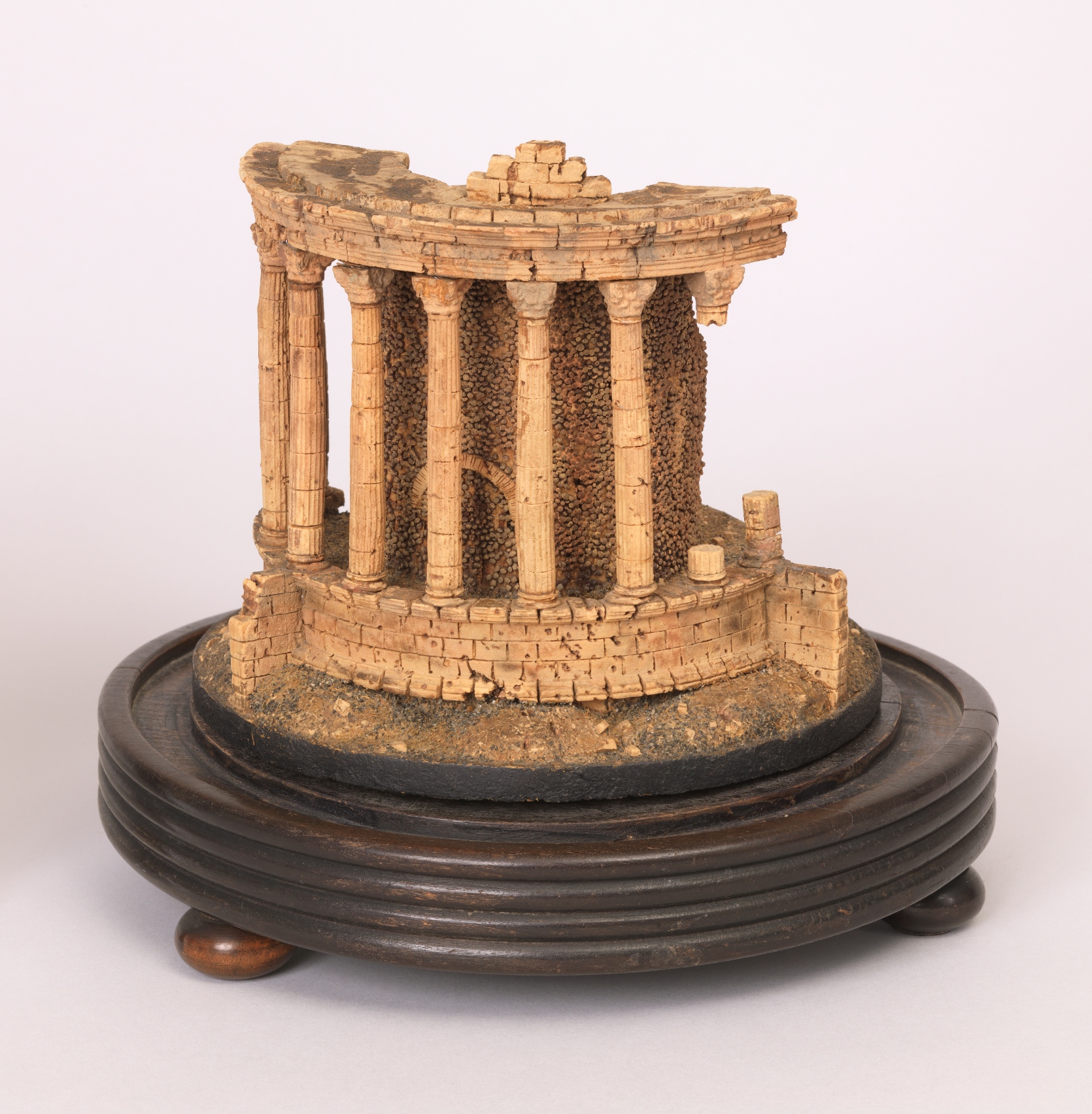The Temple of Vesta in Tivoli is one of the most illustrated and visited of the ruins of antiquity. It featured heavily in paintings and engravings as well as being the subject of model making. One important example, is a cork model a recent addition to the models collection at Cooper Hewitt, made in either Rome or Naples, but probably for a foreign collector probably on the Grand Tour. The fashion for cork models started with the revival of interest in the classical period and the Grand Tour in the mid -eighteenth century and reached it zenith around 1800-1830. Meticulous workmanship and an exacting sense of proportion produced a model that was faithful to the full scale building. To make the models, curved cork boards from Southern European cork trees were flattened in presses for an extended period, before being shaped and sculpted with sharp tools. The porous nature of cork was ideal for creating the impression of the worn marble of the original buildings, the softness of the material enhancing carving in minute detail as seen in this model of the temple in a semi-ruinous state. Scale and detail together were important, especially for students of the architecture and design details. The cork’s lightness made the models more transportable.
These models were both used to “collect” important architecture, and as teaching tools. Architect Sir John Soane had a models room, from which he taught. Soane also used models as inspiration for his own architecture. In his model room were several cork models including one of this building-Soane’s favourite-the Temple of Vesta at Tivoli, in addition to a large cork model of Pompeii and others of temples at Paestum. His Model Room incorporated buildings Soane admired and that influenced him and served to replace the Grand Tour for those students unable to travel to Italy and Greece to see the actual buildings for themselves. He looked on them as good substitutes for going on the Grand Tour from the point of view of teaching architecture.
The Victoria and Albert also has a cork model, of the Temple of Concord in Agrigento, in Sicily, one of five exhibited in the museum’s very early days in the 1860’s.
Several key figures are associated with the development of cork models: Augusto Rosa (1738-1784), a Roman architect who supplemented his practice through production of cork models of ruins in and around Rome, sometime in the 1770’s-80’s may have been the primary inventor of such exact architectural modelling in cork. Other makers such as Giovanni Altieri (1767-1790) and Dominico Padiglione and sons in Naples, ran workshops which used measured drawings to produce models as well. Others include, Antonio Chichi (1743-1816) and a German Carl May (1747-1822). While it is as yet not possible to definitely attribute this model, the location of the Temple of Vesta, in Tivoli, not far from Rome, may suggest a Roman maker, although detailed engravings with measurements were becoming popular sources too.
Today, models are still important and used by designers in a number of disciplines. They often collect examples from the past, and appreciate the role the model plays in the design process, from inspiration to presentation, and not least because of their visual appeal as objects to collect. I really look forward to engaging the design community in conversation about what these models mean to them, and what they use models for in their own work when this model and others go on display in Cooper Hewitt’s Models & Prototypes Gallery at part of the opening exhibitions of the museum on December 12, 2014.
I am grateful to Jonathan Coulborn of Thomas Coulborn, for his insight and scholarship on the subject of cork models.
Sarah Coffin is the Head of the Product Design and Decorative Arts Department at Cooper Hewitt Smithsonian Design Museum. She curated, among other exhibitions, Made to Scale: Staircase Masterpieces The Eugene and Clare Thaw Gift.

2 thoughts on “Cork for more than Wine–The Temple of Vesta, Tivoli”
Payman on May 26, 2017 at 9:48 am
Hi dear madam or sir
We have a cork tableau from 17 th century. We want to sell it can you help us?
Regards
Valentin Kockel on December 10, 2017 at 3:58 am
Dear Ms. Coffin,
it seems to be quite a tiny model. I wonder if you could you please provide me the hight and/or diametre of the model? Is the glass case still existing?
Thank you so much